Check out this 2018 update of using Skype in the classroom, complete with a PDF full of tips to ensure your Skype call goes smoothly!
Increasingly, educators globally are transforming their classroom using Skype to create powerful, authentic, motivating learning experiences for their students.
From connecting with classrooms in other locations to learning about each others’ culture to connecting with content experts — educators are extending learning beyond classroom walls.
So how do you use Skype effectively with your class?
Hopefully this will help!
Here’s our educator’s guide on every thing you need to know about Skype from……
1. Setting up your account
A. Installing Skype and creating your Skype username
B. Setting up your Skype Profile
C. Updating your Privacy Options
D. Configuring your Audio and Video settings
E. Adding People To Your Skype Account
A. Skype Status
B. Sending or Receiving an Instant Message
C. Calling someone who’s on Skype
3. Using Skype in your Classroom
A. Setting up the equipment
B. Using the microphone and video
C. Being part of the audience
D. Using the Chat window
E. Finding classes and content experts to connect with
Alternatively, here’s The Complete Educator’s Guide to Using Skype effectively in the classroom PDF version — for you to download and print off.

About Skype
Skype is a free application that allows you to call people from all over the world using the Internet.
When you contact another person that uses Skype you talk or chat for free.
Best of all you can tell when another user is online and what their status is so you know if they are available.
Setting up your Skype account:
A. Installing Skype and creating your Skype username
Before you can use Skype you must install it on your computer and set up a Skype account.
Here’s how you do it:
1. Download and install Skype from the Skype website
2. Once installed open Skype and you’ll see a start-up screen
3. Click on Don’t have a Skype Name?

4. Follow the directions to create a new Skype account and username then click Sign In
- Remember first impressions count! Choose your username carefully
- Choose a username that makes it easier for others to find you and conveys the right impression of who you are
B. Setting up your Skype Profile
Before adding contacts to your Skype account it is important to set up your Profile.
The more relevant the information you include in your Profile the easier it will be for others to ensure they’re connecting with the right person.
To change your Profile you need to:
1. Click on the Profile tab
- or select Skype > Profile > Edit Your Profile from the menu bar

2. Change Your Picture by clicking on Choose picture from file
- or select Skype > Profile > Change Your Picture from the menu bar
- It’s harder to located the correct contact without a profile picture and you’re less likely to added as contact if you’re using the default avatar.
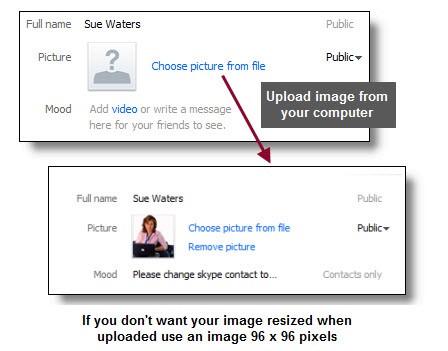
3. Add your Country/Region, State/Province, City, Time, website (if applicable), gender and language by clicking on each field or using the drop down menu.
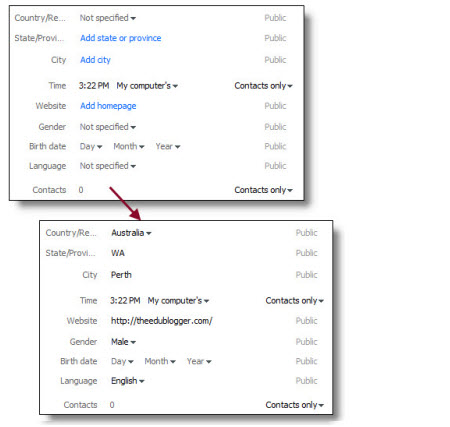
4. Complete your About Me information.
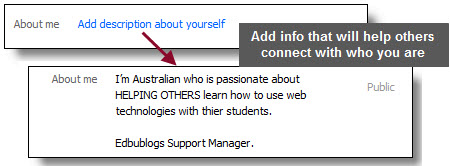
5. You can check how others will see your profile information by clicking on the Public profile and Contacts only buttons at the top of your Profile page.

- Public Profile is what people see when they search for your Skype contact details.
- Contacts Only are what people who have been added to your Skype account can see.
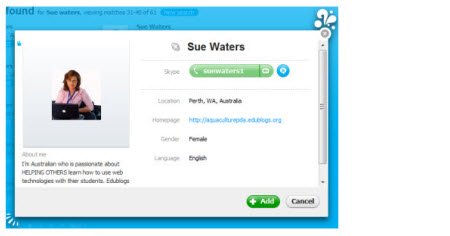
C. Updating your Privacy Options
Your privacy settings control who can contact you via Skype, how long your IM history is kept and is used to manage blocked users. It’s worth adjusting these before getting started using Skype.
By default, only the people on your Contact list are able to:
- See your profile picture
- Application share their screen
- Video talk with you
- Send IM’s
While anyone on Skype who searches for you can add you as a contact or call you.
To change your privacy settings select Skype > Privacy in the menu bar.

What privacy options you choose is entirely up to you!
However, if you want to minimise unwanted calls from anyone you might want to change it to “Allow calls from …. people in my Contact list only”
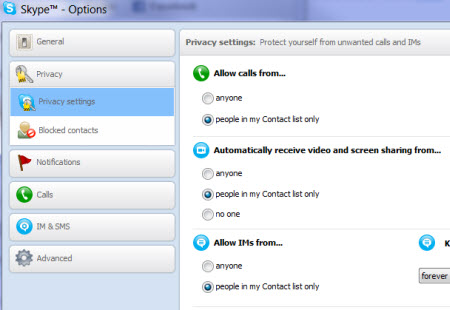
D. Configuring your Audio and Video settings
It’s best to make sure your audio and video is set up properly before using Skype to make calls.
There’s nothing more annoying frustrating than the other person not being able to hear your voice and/or you not being able to hear theirs.
To make calls you’ll need to have either:
- Headset with microphone
- Microphone with speakers
Equipment for personal Skype calls:
- In built microphone and speakers on laptops work fine but you may need to adjust the sound setting to prevent the other person hearing their own voice feedback by your computer
- Comfortable headset with microphone is recommended if you’re planning to use a lot and for extended periods
- Headset choice is very personal however I use Logitech Laptop Headset H555. Cheap headsets work just as well
- Alternatively, use a cheap desktop microphone with speakers
- Web camera (optional) – dependent on whether you like to video talk
Equipment for Skype calls in classrooms:
- Desktop microphone
- Speakers
- Web camera
- Interactive white board for display or a data projector if video conferencing with another class
Once your Skype equipment is connected to your computer all you need to do is configure your Audio settings by going to Call > Audio Settings in the menu bar.
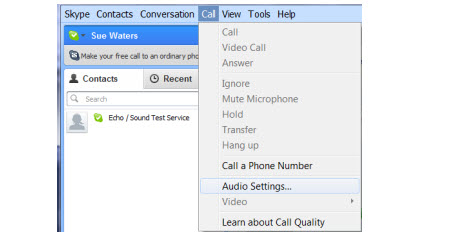
Now just select your Microphone and Speakers from the drop down options.
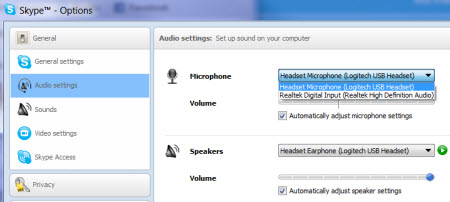
Repeat the same process to set up your web cam using the Video Settings options.
Testing your Audio, Sound and Video quality is as simple as:
1. Click on Echo / Sound Test Service
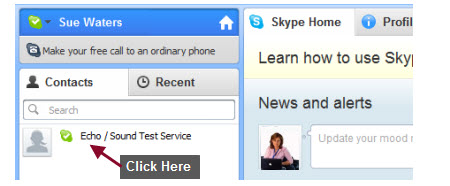
2. Click on Call
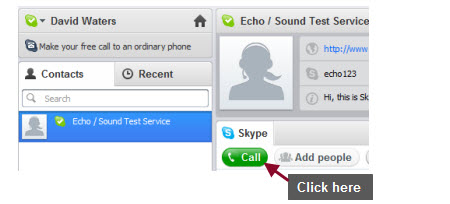
3. Now follow the instructions to test your set up using Skype’s automatic sound test service
- If you don’t hear any sound you’ll need to check your set up
4. Alternatively, you can click Check Settings to the right of Call.
![]()
E. Adding People To Your Skype Account
To contact people you will need to add their username to your Skype account.
The easiest way of finding someone’s Skype username is to contact them to ask:
- If you could add them to your Skype account
- For their username
However, you can easily search for friends’ Skype account using their email address or name.
You add people to your account by:
1. Select Contacts > Add a Contact in the menu bar or click on Add Contact.
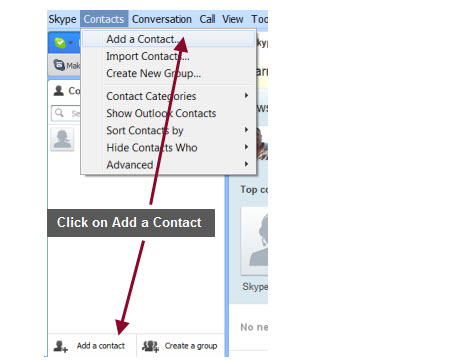
2. Enter their full name, email address or Skype name.
3. If the Skype account of the person you wish to add is displayed, click Add below the contact.
- Clicking on their Avatar displays all their profile information
- If more than one Skype account matches your search, click on view to check out all matches found.
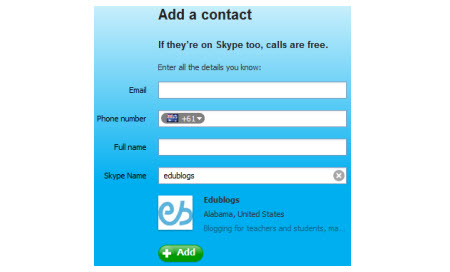
4. Before the contact can be added, you must send a contact request to that person. Enter some text to introduce yourself and click Send request.
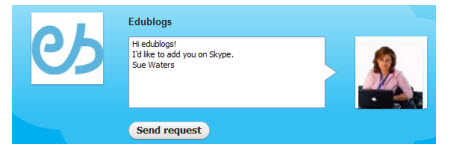
5. The contact will be added to your contact list, but will appear offline until they accept your request.
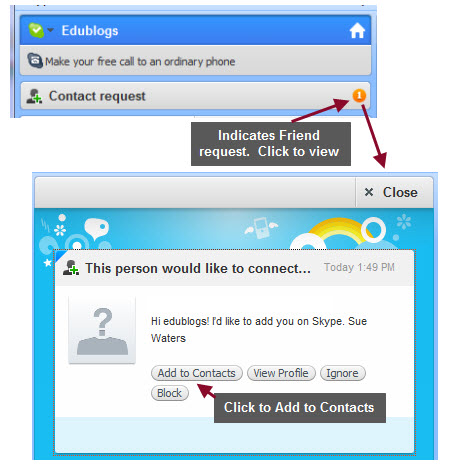
6. Once the person agrees to your request, they will be added to your Contact list. You can then make free calls and video calls to that person, and send instant messages and files to each other.
- Occasionally they won’t receive your notification to add to their contact list – in this situation just ask them to also add your username to their account.
2. Using your Skype account:
A. Skype Status
Best part of Skype is you can tell when another user is online and what their status is so you know if they are available.
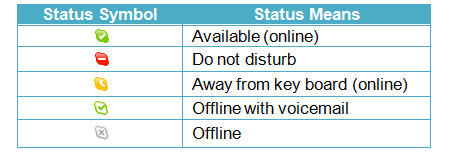
Some one’s Skype status is showing Available or Away from keyboard are normally near their computer.
However, it good etiquette to send a person a short Instant message and waiting to see if they reply rather than calling them as it might not be convenient, you might be interrupting their work flow or they may not have their audio configured.
Once you’ve engaged in a IM conversation then you can nicely ask them if they mind or if it is convenient to use voice.
Changing your Status is as simple as:
1. Click on drop down menu next to your status
2. Select your new Status
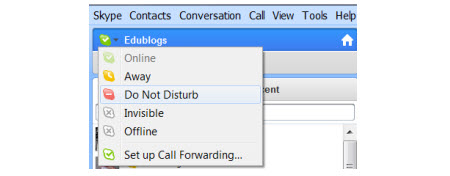
B. Sending or Receiving an Instant Message
Sending an Instant message is as easy as:
1. Find the person or group you want to message from your contact list.
2. Their username will load in the main window and you just click inside the conversation box.
3. Now type your short message and click the blue Send message button, or press Enter on your keyboard.

If someone IMs you, your Recent tab will turn orange and will show a number to to indicate how many new IM you have received.
You’ll also see an orange dot against the person’s name in your contact list who has sent the IM.
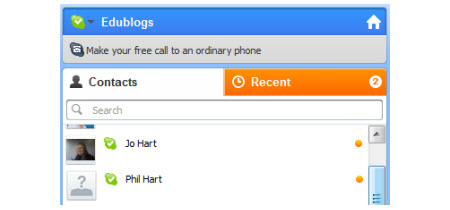
To check newly received IM:
1. Click the Recent tab. You’ll see a list of contacts who have recently contacted you using IM.
2. Unread messages are indicated by the person’s name shown in bold with a number next to their name.
3. Click on the person’s name to open up the main window and view the conversation.
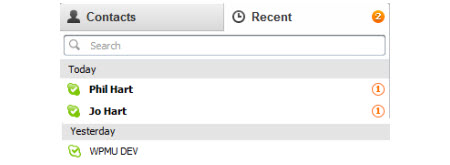
4. Type your reply inside the conversation box and click the blue Send message button, or just press Enter on your keyboard.
Other useful things you can do in an instant message include:
1. Add more people to the conversation to create a group IM
- Click on Add People
- Choose their names from the Contact list and click Select
- Now click Add

2. Use emoticons or add small pictures to show how you are feeling
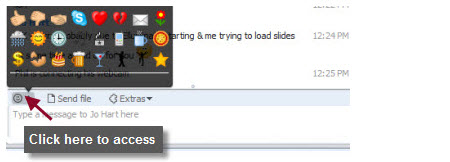
3. Send documents, photos or videos

4. Use Extra features like play games and personalise your Skype. Read more about Extras here.
C. Calling someone who’s on Skype
Remember it good etiquette to send a person a short Instant message and waiting to see if they reply before calling them as it might not be convenient, you might be interrupting their work flow or they may not have their audio configured.
Once you’ve engaged in a IM conversation then you can nicely ask them if they mind or if it is convenient to use voice.
Calling someone who’s on Skype is as easily as:
1. Find the person you want to call by looking in your contact list.
2. Check their Skype status and if they are available click their name. You will see their details in the main window.
3. Click the green Call button . You should hear ringing. If you don’t hear the other person or they can’t hear you, click the call quality icon in the call bar .
4. Hovering your mouse over the main window during a call brings up the Skype menu items which you use to access different Skype features.
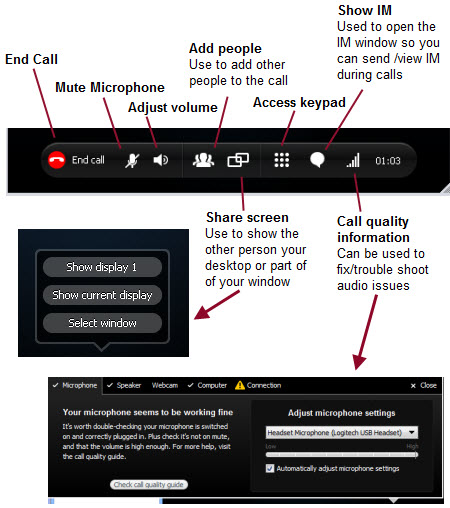
5. To hang up, click the End call button.
3. Using Skype in your Classroom
Using Skype with your students does require new skill sets to developed.
For good video quality students need to think more about impact of:
- Their own movement
- Their movement of objects
- Where they place objects to display to the other class.
For good audio quality students needs to:
- Be confident
- Think about what they want to say
- Speak clearly and loudly enough
- Slow down their speech and avoid use of language specific to their country unless they explain what the term(s) means
The keys to an effective skype classroom session include take the time to:
- Practise all skills before the Skype session
- Decide what outcomes you want to achieve and plan the Skype session including the questions, what you want to discuss and show before you start
- Allocate students different job roles for during the Skype session such as webcam operator, microphone manager, speaker, photographer, film session, IM writers, live bloggers, data recorders
It’s also worth keeping parents and families informed of why and how you’re using Skype in the classroom so they feel comfortable with the process. Check out Keith Ferrell’s Rationale for using Skype in the classroom and parent permission slip — which he uses to explain the process to his families.
For detailed information on planning and running a Skype session refer to Silvia Tolisano’s:
- Skype jobs for Students
- Assessment of learning via Skype – excellent explanation of pre-activities, during skype call activities and post activities
- A few tips for student filming in the classroom
Equipment for Skype calls in classrooms:
- Desktop microphone
- Speakers
- Web camera
- Interactive white board for display or a data projector if video conferencing with another class
Below are tips adapted with permission from:
- Sue Wyatt’s Improving our Skype Calls
- Ann Mirtchin’s Using Skype in the classroom
A. Setting up the equipment
- If using a webcam where the videoconference is projected onto an interactive white board for display or via a data projector locate the webcam beside the board, so the speaker can see both the webcam and class they are speaking to.
- Have a chair near the microphone for speakers to sit on.
- Have the webcam on eye-level with the speaker so they don’t have to look up or down at the webcam as this will distort the view of the class watching.
- Set up the desks for students not at the microphone, so they can still be seen by the class you are speaking to.
- Ensure everything is set up from the start including any objects you want to share.
- Do a test Skype call with the other teacher before the day so you can both trouble shoot any video and sound issues.
- Test the equipment before starting class.
- If you experience issues with the call during the session try switching off the video to see if that helps.
- Have a management plan for discipline problems before commencing — so you can intervene quickly if needed.
B. Using the microphone and video
- Speak clearly and try to slow down your normal speech. It takes time to adjust to some accents — talking slower helps.
- Speak fluently with no small talk or swearing.
- Avoid language that is only from your country unless you explain the meaning to your viewers.
- When it is your turn to talk, make sure you know what you are going to talk about. Try to explain rather than give a one or two word answer.
- Show confidence when speaking – this might mean a few rehearsals for some students.
- If using a desk microphone, hold it straight and speak straight into it, not swinging it side to side
- Minimise too much movement of objects or people as this can cause blurring
- Left mouse click on the corner of the main window and drag to increase the window size to enlarge the video and then click on the Show IM icon so you can send IM and watch the video.
- If not using IM, then just click on Full screen to enlarge the video stream.
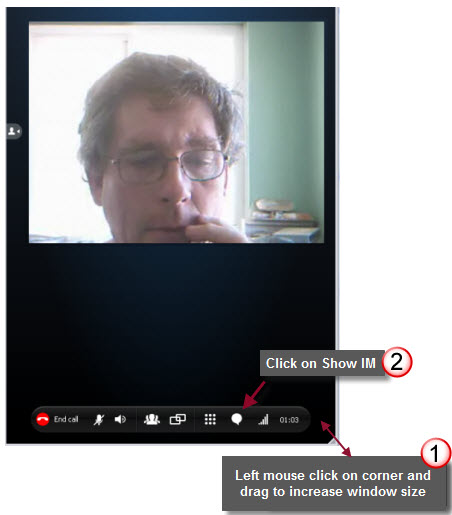
C. Being part of the audience
- Be quiet when someone is speaking on the microphone.
- Listen attentively when you are not the speaker, as you might know the answer to the question being asked by the other class.
- Ideally only one person should speak at a time
- Don’t sit friends near each other as they will tend to distract each other when not the speaker.
- Sit where you can see and hear the conversation but where it is also easy to get up and go to the microphone.
D. Using the Chat window
IM is excellent for feedback and questions.
It’s especially ideal when connecting with classes that English isn’t their first language, or when sound quality isn’t good — it’s a great way of typing in key phrases to ensure information is being understood.
- Use IM to send a quick message to check the other class is ready before calling.
- Allocate students to be in charge of the IM conversation during the video conference and provide them clear guidelines of their role.
E. Finding classes and content experts to connect with
Here’s where you’ll find some connections to get you started:
- Skype other Classrooms!
- Around the World with Skype – scroll down page
- Skype in the Classroom website
Final thoughts
Would love to hear about your experiences!
What advice have we missed? What other advice would you give educators using Skype in their classrooms?
And we’d love to hear what you’ve gained from using Skype in the classroom — please leave a comment to let us know.
If you are enjoying reading this blog, please consider ![]() Subscribing For Free!
Subscribing For Free!



An excellent article for those new to using Skype for teaching. I own an online Spanish school and have been tutoring using Skype for over 4 years. The quality of connections has improved dramatically and I am finding most new students already have Skype, so it is much more natural for them to use.
Hi, this is really helpful, thanks. I held a coaching session with a student the other day via Skype and her Skype kept disconnecting. This leaves me feeling nervous about using it for larger scale teaching. What can I do to ensure students have access that is consistent?
thanks,
Illysa
Hi Illysa, you can find variations with connections on Skype which is why it is important to pretest your connections the day before. However, most people will be aware if they experience connections issues so you can plan around this.
I do believe that the gains are definitely worth it. You really do empower your students when they learn how to use these types of tools. My husband isn’t the greatest with technology and it is pleasing to see my kids taking over and being able to quickly connect on Skype wherever they are and contact me when I’m travelling.
I’ve used it to communicate with students who have had multiple absences due to illness in order help them stay current with the class and let them know how much they are missed. Our class has also chatted with classes in other locations to talk about science projects, math investigations, performed plays and songs and challenged each other to various “quests”. We’re hoping to get to stay in touch with some friends that have recently moved by Skyping with their new classes and broadening our peer/ colleague base.
I’m planning next year to use it to communicate with parents when they can’t come in for a conference due to travel, etc. At the beginning of the year I’ll ask parents to share their Skype names with me so I can put those in the system. It will come in handy during the year for impromptu career day class talks but instead of waiting until career day we can schedule it point of need as we are studying certain related content. You’re welcome to share any ideas.
Hi Keith, the trouble is as you highlighted in your post is traditional media constantly warns of the dangers while failing to showcase the great things it has done.
Hi Carla, glad you’re found my post useful. Always happy for others to refer to it and link. It’s only when someone copy/pastes a large amount of the text and images I’ve written that I get annoyed.
Thanks Buxxiebeeteacher for sharing, hadn’t thought about using it for role playing. What a great idea and all students benefit from gaining the skills!
Just a quick suggestion for how to use Skype in the classroom. This was used to support our autistic classroom. I set up two stations with skype. Both were isolated from one another so sound was not bleeding through the rooms.
Next, I gave the students in my regular classroom one scenario and the autistic support students another. They went to the stations and role played the scene. For example: call the doctor and make an appointment. Regular students were the receptionists and the autistic support students were the callers. This was a great experience for all in using the phone effectively.
Hi Sue
Thanks for compiling such a thorough guide to Skype in the classroom. I’ve used it a bit at home, but hadn’t really given much thought to how I could use it in the classroom before. This is really awesome! It’s also inspiring to read that other teachers are trialling this in their classrooms and sharing the results.
Would you mind if I referred to this guide on my website with a link?
Cheers,
Carla
As always, a great, thorough, pertinent post. Thank you! We’ve recently begun Skyping in my school and have had some amazing experiences. We’re set up a “Skype-in Friday” where for 30 minutes each Friday morning, parents and grandparents can Skype-in and chat with their child/grandchild to get a summary of the week’s learning.
One thing to note about using Skype: there may possibly be parents concerned with the idea. I’ve highlighted some rationale for using Skype in the classroom on my blog that will hopefully help teachers embarking on a Skyping adventure: http://edtechideas.com/2011/04/05/rationale-for-using-skype-in-the-classroom/
Thanks for all you do!
Hi Keith, thanks for bringing the concerns of the parents and family to my attention. I hadn’t considered that aspect with parents. I’ve left a more detailed comment on your post but hope it is okay? But plan to update my post to highlight informing parents then I’ll recommend they check out your post and permission letter.
Thanks Sue. I hadn’t expected such a concern either, but a little education goes a long way.
Great guide! I would add to join Skype in the Classroom, a forum for educators to connect with each other and with projects. I think a lot of teachers don’t know anyone else on Skype so they don’t see the purpose.
Thanks Chelsy for your nice feedback. Skype in the Classroom website is included in the post but it is perhaps hidden amongst all the information under classroom.
I’ll look at editing the post later to see if I can add some graphics to make it stand out more.
Hi There!
As a high school English teacher in Ontario, Canada I am always looking for valid oral language opportunities for my students. I have used Skype to connect with professionals in different parts of north America. These speakers are usually everyday people doing what my students are interested in doing for a career. (Bakery owner, Truck Driver, Artist, Inspirational Speaker) My students do a little research about the person we are preparing to interact with and then they make predictions and generate questions for this person in small groups.
We usually give the speaker 10 minutes to speak to the group and then we open it up for questions from the class. Students must actively listen to the answers so that their questions and comments are not duplicated. It is an excellent tool for getting in speakers for little to no money.
As a culminating, students will respond to the speaker on a blog or through email. Depending on the intention of the lesson, we may do a shared writing mini-lesson to respond as a class. I always want my students to learn from the people around them and to apply this learning to their lives. This has been very powerful for students and it is simple to use.
Thanks for the topic,
JL
Can you share some details of your group in terms of number of participant at one time, quality of connection, dealing with connection? My concern is that I tried to participate a few times in a group laughing exercise via Skype (laughter club) and the quality of the connection was so bad, I wonder how you could manage to upkeep the quality of the collaboration when sound and or video quality drops below acceptable level. How do you deal with such experience (if it happened to you)
I used Skype with a class of 25 to one speaker. I have also connected classrooms together. We have ground rules that ensure that all students are actively listening and being respectful to one another during the discussions between classrooms.
I have always been concerned about the connection quality and have found great success bypassing the school connection by tethering my iphone to my laptop for a clear connection. The microphone and camera on my apple is great for the situation. I just make sure we do not Skype for longer than 15 minutes. This limits the GB’s I use on my cell phone plan.
Always have a back up plan…respond through the chat feature of the Skype, send emails with question and answer sessions.
Also, if Skype isn’t working well, another option is sometimes gmail. If both people speaking have an account then the video chat can happen this way too.
Even though it seems like an uncertain thing and a hassle at times, I refuse to not do it because of the risk that it might not work. It is just too valuable an experience for my students. I’m sure you agree. 😉 All the best! JL janetlee.edublogs.org
I am happy to share a year later that Skype has been a great experience for my girls talking to grandma.
She actually become a virtual babysitter at times with great success and my 5 & 6 years old (one is now 7) are totally adopted Skype as part of their lives. They actually ask for Skype first before asking for phone. Of course it helps when their daddy is on Skype everyday conducting business. Now I am looking for K12 groups to connect with especially around the topic of Thinking Skills. In all other subjects I have no problem finding local resources but THINING. Seems to me this topic is now a Taboo and people run the other way when I bring this subject up for discussion. Anyone out there practicing the De Bono lessons or working the SOT that is School of Thinking? I would love to connect to practice thinking skills. Z